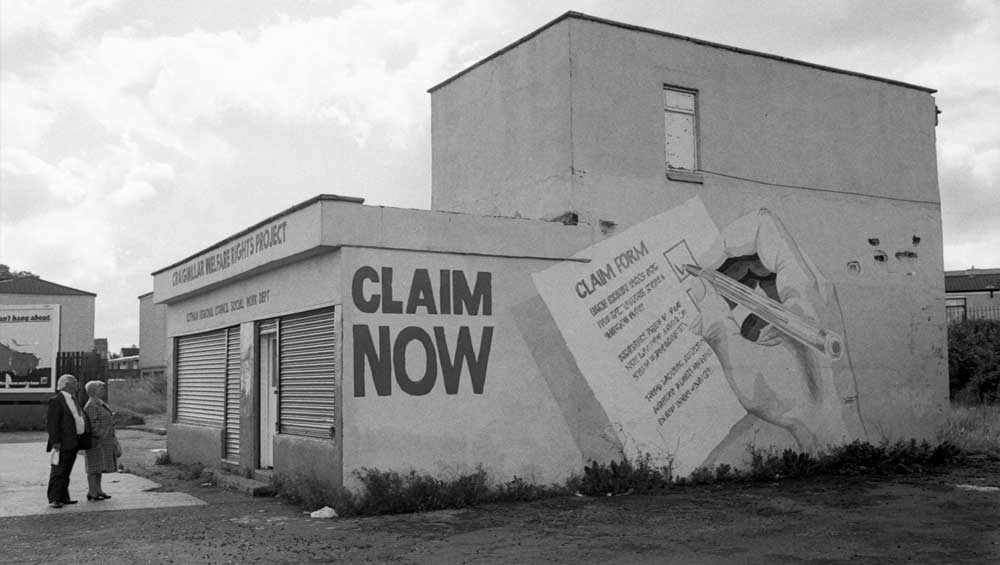
Sandra George. Claim Now: Craigmillar Welfare Rights, 1988. Image courtesy of Craigmillar Now.
5 Florence Street, Glasgow International Festival of Contemporary Art
7 – 23 June 2024
by BETH WILLIAMSON
An exhibition of photographs by Sandra George (1957-2013), and presented by Glasgow School of Art Exhibitions, is surely the five-star show of this year’s Glasgow International. With so much to see and do across the city during its festival of contemporary art, this exhibition is a must-see. Sensitively curated by Jenny Brownrigg, and in association with Craigmillar Now, the community-led arts and heritage organisation that holds George’s archive, this exhibition is spread across two rooms on the second floor of a 19th-century school building in Florence Street in the Gorbals where George’s photographs look perfectly at home. The former Adelphi Terrace Public School, designed by the architect Thomas Lennox Watson (1850-1920), originally opened its doors in 1894 in the wake of the Education (Scotland) Act of 1872, which made schooling for five- to 13-year-olds free and compulsory. Now used as a creative space, the building is just beyond the city centre, on the fringes, and that suits George’s work entirely.
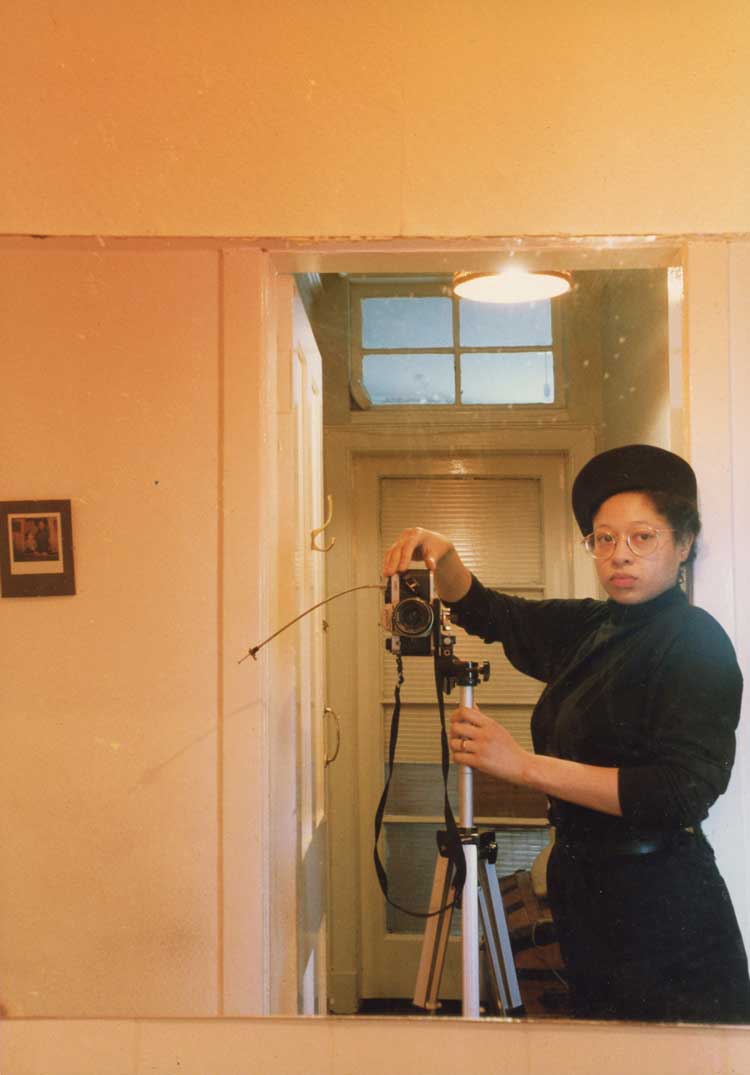
Sandra George. Self portrait, Bread St, May 1993. Image courtesy of Craigmillar Now.
Born in Nottingham, George grew up in Jamaica, Birmingham and Edinburgh, where she became a community worker in the Craigmillar area of the city. From the 1980s onwards she used her camera to document the people and projects she worked with in the community. With an ethics of social justice and equality at the heart of everything she did for more than 40 years, her camera became an extension of her community work, a tool through which she could care for and give voice to those who often remained invisible.
George gained a BA in photography at Napier University (1979-82), followed by a BA in fine art at Edinburgh College of Art in drawing and painting (2001-2004). In 2004, she also graduated in community education at the University of Edinburgh. In the 1980s, she worked in community development in Wester Hailes then, in the 1990s, worked in Craigmillar, Edinburgh, for organisations including McGovan House, the Thistle Foundation, and the Craigmillar Community Arts Centre. In 2008, she was youth services manager at Hunter’s Hall Cooperative, Craigmillar. That year she launched Niddrie Community Youth Group. Her credentials in community work gave her the experience and contacts necessary to approach her social-documentary photography practice with integrity and sensitivity. As well as taking her own photographs in Craigmillar, Edinburgh and Scotland more widely, George was also a freelance photographer for more than 30 years for organisations and publications such as Shelter, the Craigmillar Festival News and the Craigmillar Chronicle.
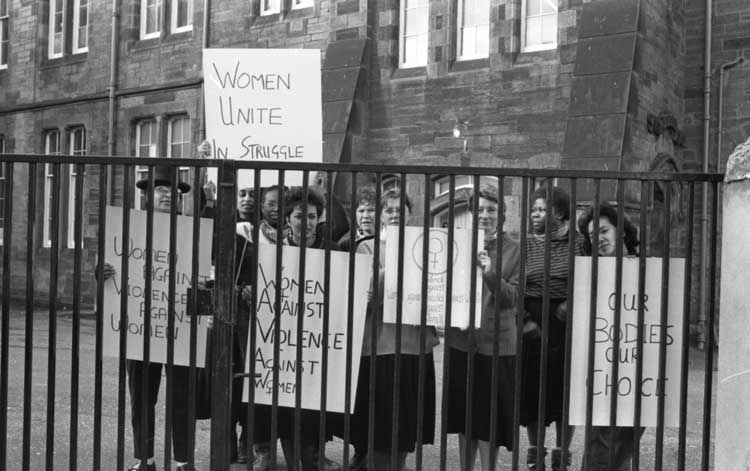
Sandra George. Stage Picket at MEC, Leith Walk Primary School, Edinburgh, 1990. Image courtesy of Craigmillar Now.
Her subjects included the people she encountered at the Victoria hostel in Edinburgh. Embedded and established within the local community, George recognised: “Sometimes the most meaningful experiences come from seemingly simple acts or verbal expression.”1 Further, she spent extended periods with those communities she photographed. As her former partner, Jimmy Hewitt, recalled: “Sandra was photographing women living in the hostel going about their daily lives. Sandra being Sandra would spend days and nights staying in the hostel with the women.”2 For George, the hostel was not simply a faceless institution populated by nameless women in difficult circumstances. It was a place where individual women made their homes, domesticating their personal space and imprinting it with something of their own unique identity.
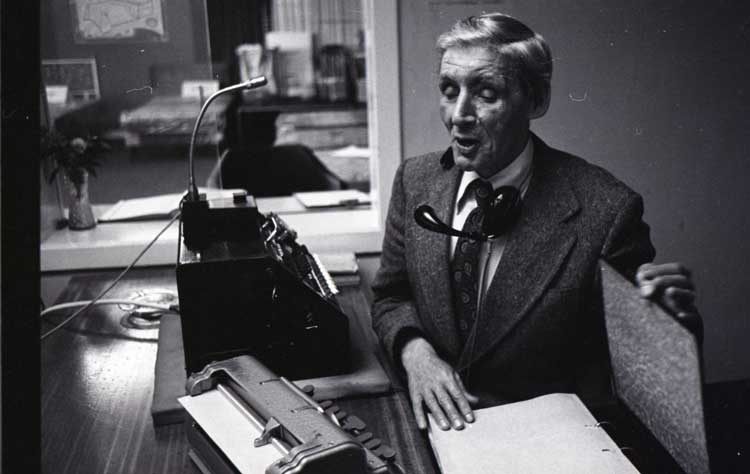
Sandra George. Blindcraft, Edinburgh, 1980. Image courtesy of Craigmillar Now.
The Edinburgh BlindCraft Bed Factory in Craigmillar was another potent subject for George. Present in one form or another since 1793 when it was the Royal Blind Asylum, the factory closed in 2011, shedding its, mostly, disabled or visually impaired employees. Coincidentally, Brownrigg comments that many visitors to the exhibition remember the factory and its wares, as do I. George documented the working lives of these people, using photography to share the story of those without vision. One particularly poignant photograph shows a pair of disembodied hands reading a text in braille. In another group of photographs, Asian shopkeepers stand defiant against a backdrop of racist graffiti. At every turn, her photographs show individuals overcoming difficult circumstances of one sort or another and contact sheets demonstrate just how many photographs she took in order to select just one. Protests over a range of issues feature in her work too – Nelson Mandela, the ANC, Access Ability, unemployment, an elderly people’s demonstration. Many corners of the city came under the scrutiny of her lens in Edinburgh – Wester Hailes, Oxgangs, Granton, Greendykes, Niddrie and Craigmillar.
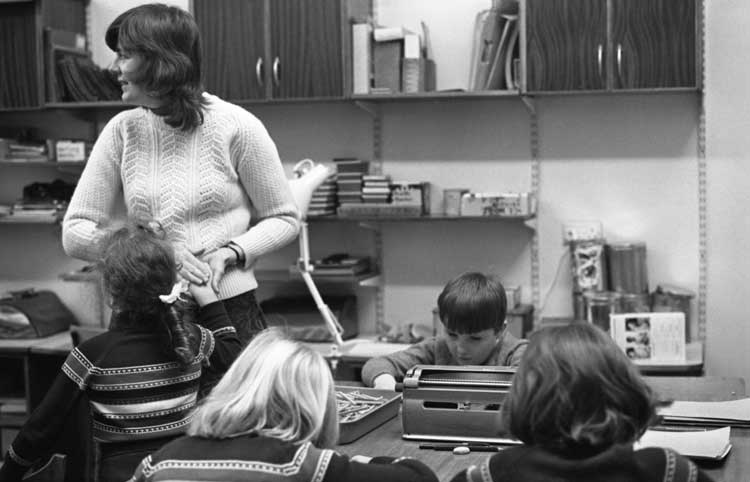
Sandra George. Royal Blind School, December 1980, Edinburgh. Image courtesy of Craigmillar Now.
George explored her own identity through her photography and other practices – printing, painting, jewellery and book works feature, too, including some tender preparatory drawing for A Book for Georgie, an unrealised children’s book that she began for her grandson Georgie before she died. Still, it is through photography that she articulates most clearly. Her photographs of children in schools and playgrounds exude a mischievous sense of joy. In her self-portraits and portraits with her son, Tyler, George is self-confident and self-fashioning, often showing the camera, or its shadow, claiming her identity as artist and perhaps claiming a creative place in the world for her son too.
The identity of the communities and individuals with whom she worked daily is what George valued. In her artist’s book Identity in 2004, George laid out her beliefs: “I commence from a privileged position, one of experiencing and observing difference in different settings. Identity in this regard is an important personal consideration, having to constantly observe descriptions and statements which are given credence as being significant and deemed a meaningful portrayal of society in the 21st century. The official form of culture described as mainstream seems alien to me, as I recognise individuals and not the classification of people. The ‘mainstream’ attitude only serves to perpetuate antiquated and mythological views of culture and society.”3
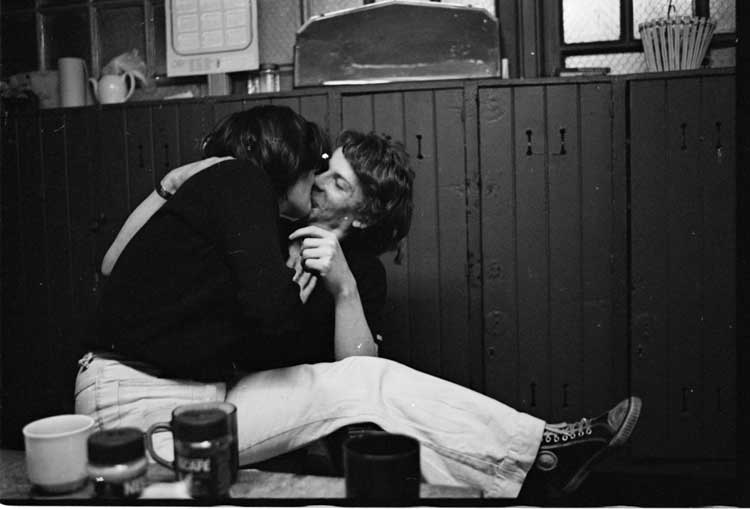
Sandra George. Victoria Hostel, Edinburgh, 1981. Image courtesy of Craigmillar Now.
The social issues that George dealt with in her practice as a community worker and photographer remain as relevant as ever in the present day. George’s photographs quietly gave agency to her subjects in her lifetime. In this exhibition, George’s work finds new audiences, gives her agency and purchase in a crowded art world, quietly asserting her right, and the right of those she photographed, to be part of that world too. It is a blessing that her archive is just where it should be, safe in the hands of a community-based organisation, close to the people she cared passionately about. Important issues of community, care, accessibility and equality in the arts and workplaces, identity, and working with those in under-reached communities, are brought to the fore once again. Not all art can make a difference but this exhibition, and George’s work, has real potential to do just that.
References
1. Sandra George in an Address Book belonging to Sandra George, courtesy of Craigmillar Now. This book contains Sandra’s writing on photography. This item was selected by Christian Noelle Charles for the exhibition.
2. Jimmy Hewitt, quoted on exhibition label.
3. This transcript is from Identity, an artist book by Sandra George, courtesy of Craigmillar Now. Produced March 2004 Sandra George.